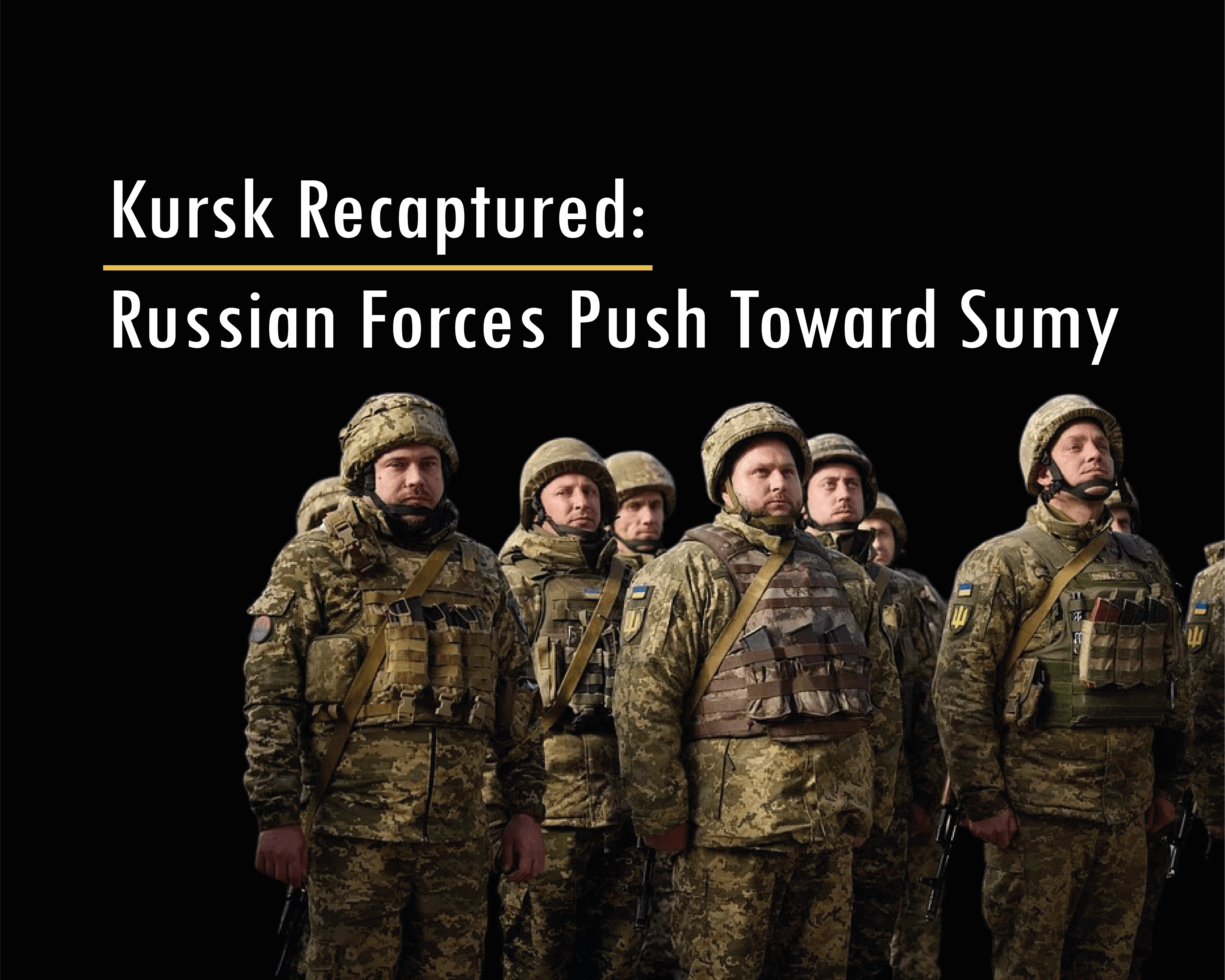Amid escalating hostilities in northeastern Ukraine, Russian forces have regained control of most of the Kursk region and are pushing toward Sumy. Intensified drone warfare, North Korean troop involvement, and strikes on critical infrastructure mark a volatile phase in the conflict.
Territorial Gains and Military Operations
Russian forces have retaken nearly all of the Kursk region and are continuing their advance into northeastern Ukraine. Ukrainian troops now control approximately 80 square kilometers of Russian territory, a significant reduction from the estimated 1,000 square kilometers held in August 2024. On March 28, the Russian Ministry of Defense reported that its North Military Group took control of the settlement of Gogolevka and engaged Ukrainian units from five brigades in areas including Gornal, Guevo, and Oleshni.

Between March 8 and 14, Russian troops reportedly recaptured over 30 settlements, including the town of Sudzha. Russia is believed to have deployed between 50,000 and 80,000 troops in the region.
The fighting in the Sumy region has been heavily influenced by Russia’s growing air dominance. Russian operations have increasingly relied on fiber-optic drones and glide bombs (BGPs) capable of carrying up to three tons of explosives. Ukrainian fortifications, bunkers, and structures have suffered heavy damage from these strikes.
In addition, Russian troops can still count on the support of North Korean troops, deployed in Ukraine in December 2024. South Korea’s Joint Chiefs of Staff stated that an additional 3,000 North Korean soldiers were sent to Russia between January and February 2025. Of the 11,000 deployed since 2024, approximately 4,000 have reportedly been killed or wounded. Deployment errors in 2024 caused significant casualties within the ranks of the Hermit Kingdom, but these units have since reportedly adapted to modern tactics, including drone warfare.
According to some Ukrainian officers, Russian forces demonstrate greater tactical proficiency than those encountered in 2022 and 2023. The fluid front in the Sumy region contrasts with the more static lines in Donbas and Zaporizhzhia, where Russian offensives have reportedly stalled.
To counter Russia’s momentum, Ukrainian forces launched a limited incursion near Demidovka in Russia’s Belgorod Oblast, but its success in terms of territory gains remain limited.
Energy Infrastructure and Cross-Border Strikes
On March 28, Russian sources report that Ukraine launched a double HIMARS strike on the Sudzha gas measuring station in Kursk Oblast, causing a fire and extensive damage. Russian officials claim the site was nearly destroyed. Additional Ukrainian strikes targeted a refinery in Saratov Oblast and a power facility in Belgorod Oblast.
The Russian Ministry of Defense accuses Ukraine of violating a commitment to halt attacks on civilian energy infrastructure, suggesting such strikes undermine potential ceasefire negotiations. Russian authorities argue that Ukrainian President Volodymyr Zelensky’s ceasefire rhetoric is part of a broader strategy to stabilize the front and regroup with Western support.
In parallel, Ukrainian officials reported that Russian drone and missile strikes have also continued. On March 27, a Russian attack on Kherson damaged local energy infrastructure, killed two people, and injured at least five others. A day later, on March 28, a Russian drone strike hit gas storage and administrative facilities in Ukraine’s Poltava region, damaging infrastructure belonging to the national energy company Naftogaz.
Strategic Implications
The evolving dynamics in northeastern Ukraine point to a potentially decisive phase in the conflict:
- Russia’s regaining of the Kursk region and its push toward Sumy suggests a shift in momentum, particularly in sectors where Ukrainian defenses are less fortified compared to Donbas or Zaporizhzhia. If Russian forces consolidate their hold in this area, they may establish a new axis of pressure threatening Ukraine’s northeastern interior and logistics hubs.
- With two recent ceasefire arrangements—one focused on energy infrastructures and another on navigation in the Black See—there are growing signs that direct negotiations between Ukraine and Russia may become more plausible. However, Russia’s steady advance in Donbas and Ukraine’s loss of the Kursk foothold have deprived Kyiv of key bargaining chips, potentially weakening its position at the negotiating table.
- A renewed Ukrainian incursion into Russia’s Belgorod Oblast could shift the operational balance, especially as Russian forces remain concentrated around Kursk and Sumy. However, the successful operation in August 2024 owed much to the element of surprise. Since then, repeated Ukrainian attempts to breach into Belgorod have achieved limited tactical gains and failed to replicate earlier momentum, suggesting diminishing returns from such cross-border raids.
- The energy infrastructure ceasefire highlights how fragile any de-escalation agreement remains. Ongoing strikes on civilian and industrial targets risk prolonging instability, fueling retaliatory cycles, and undermining diplomatic trust.

